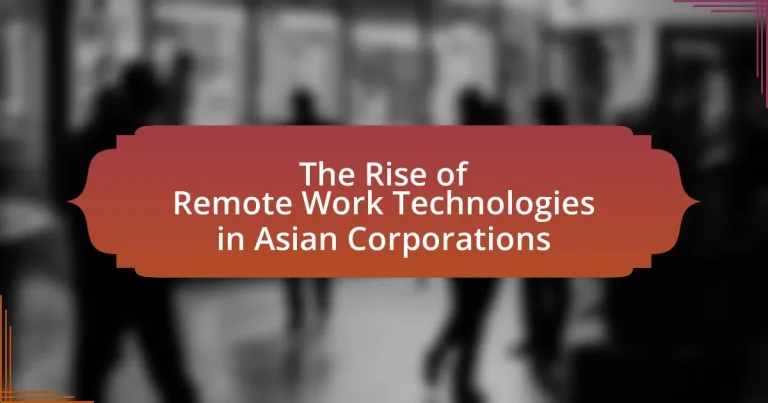The article examines the rise of remote work technologies in Asian corporations, highlighting their critical role in facilitating collaboration, communication, and productivity, especially during the COVID-19 pandemic. It discusses the evolution of these technologies, driven by advancements in internet infrastructure and changing workforce dynamics, and identifies key tools such as video conferencing software and project management applications. The article also addresses historical factors influencing this trend, the challenges faced by corporations in implementing these technologies, and the long-term impacts on corporate culture and employee engagement. Additionally, it explores future trends, including the integration of artificial intelligence and virtual reality in remote work practices.

What are Remote Work Technologies and Their Importance in Asian Corporations?
Remote work technologies are digital tools and platforms that facilitate remote collaboration, communication, and productivity among employees. Their importance in Asian corporations is underscored by the rapid adoption of these technologies, particularly during the COVID-19 pandemic, which accelerated the shift to remote work. According to a report by McKinsey, 70% of employees in Asia expressed a desire to continue working remotely at least part-time post-pandemic, highlighting the effectiveness of remote work technologies in enhancing employee satisfaction and productivity. Furthermore, tools such as video conferencing software, project management applications, and cloud storage solutions have enabled Asian corporations to maintain operational continuity, reduce overhead costs, and access a broader talent pool, thereby driving innovation and competitiveness in the region.
How have Remote Work Technologies evolved in Asia?
Remote work technologies in Asia have evolved significantly, driven by advancements in internet infrastructure, software development, and changing workforce dynamics. The proliferation of high-speed internet and mobile connectivity has enabled seamless communication and collaboration across borders, facilitating remote work. For instance, countries like South Korea and Singapore have invested heavily in digital infrastructure, resulting in internet speeds that rank among the highest globally.
Additionally, the rise of cloud-based platforms such as Zoom, Microsoft Teams, and Slack has transformed how teams interact, allowing for real-time collaboration regardless of location. According to a report by McKinsey, 70% of companies in Asia have adopted remote work technologies since the onset of the COVID-19 pandemic, highlighting a rapid shift in corporate practices.
Furthermore, cultural attitudes towards remote work have shifted, with more organizations embracing flexible work arrangements to attract and retain talent. This evolution reflects a broader trend towards digital transformation in Asian corporations, positioning them to adapt to future challenges in the global workforce landscape.
What historical factors contributed to the rise of Remote Work Technologies in Asia?
The rise of Remote Work Technologies in Asia was significantly influenced by rapid technological advancements, globalization, and the COVID-19 pandemic. Technological advancements, particularly in internet connectivity and mobile devices, facilitated remote communication and collaboration, making it easier for companies to adopt remote work practices. Globalization led to increased competition and the need for flexible work arrangements, prompting organizations to implement remote work solutions to attract and retain talent. The COVID-19 pandemic acted as a catalyst, forcing many businesses to transition to remote work overnight, which accelerated the adoption of remote work technologies across various sectors in Asia. For instance, countries like Japan and South Korea saw a surge in the use of video conferencing tools and project management software during this period, highlighting the shift towards remote work as a viable long-term strategy.
How have technological advancements influenced the adoption of remote work?
Technological advancements have significantly accelerated the adoption of remote work by providing essential tools and platforms that facilitate communication, collaboration, and productivity. The proliferation of high-speed internet, cloud computing, and collaboration software, such as Zoom and Slack, has enabled employees to work effectively from any location. According to a report by Gartner, 88% of organizations worldwide mandated or encouraged employees to work from home during the COVID-19 pandemic, highlighting the critical role of technology in enabling this shift. Furthermore, advancements in cybersecurity have addressed concerns about data protection, making remote work more viable for companies across various sectors.
What are the key types of Remote Work Technologies used in Asian Corporations?
The key types of Remote Work Technologies used in Asian Corporations include collaboration tools, video conferencing platforms, project management software, and cloud storage solutions. Collaboration tools like Slack and Microsoft Teams facilitate real-time communication and teamwork among remote employees. Video conferencing platforms such as Zoom and Google Meet enable face-to-face interactions, which are essential for maintaining relationships and conducting meetings. Project management software like Asana and Trello helps teams organize tasks and track progress, ensuring that projects stay on schedule. Cloud storage solutions, including Google Drive and Dropbox, provide secure access to files from anywhere, supporting seamless information sharing and collaboration. These technologies have become integral to the operational efficiency of Asian corporations, especially in response to the increasing demand for remote work solutions.
What role do communication tools play in remote work?
Communication tools are essential in remote work as they facilitate real-time interaction, collaboration, and information sharing among team members. These tools, such as video conferencing platforms, instant messaging applications, and project management software, enable employees to maintain connectivity regardless of geographical barriers. For instance, a study by Buffer in 2021 found that 98% of remote workers prefer to use communication tools to stay connected with their teams, highlighting their importance in fostering a collaborative work environment. Additionally, effective communication tools can enhance productivity by streamlining workflows and reducing misunderstandings, which is crucial for the success of remote teams in Asian corporations adapting to new work technologies.
How do project management platforms facilitate remote collaboration?
Project management platforms facilitate remote collaboration by providing centralized tools for communication, task management, and document sharing. These platforms enable teams to assign tasks, set deadlines, and track progress in real-time, ensuring that all members are aligned regardless of their physical location. For instance, tools like Asana and Trello allow users to create boards and lists that visually represent project workflows, which enhances transparency and accountability. Additionally, features such as integrated chat and video conferencing support instant communication, reducing delays in decision-making. Research indicates that organizations using project management software report a 20% increase in productivity, highlighting the effectiveness of these platforms in enhancing remote teamwork.
What challenges do Asian Corporations face in implementing Remote Work Technologies?
Asian corporations face several challenges in implementing remote work technologies, including cultural resistance, inadequate infrastructure, and cybersecurity concerns. Cultural resistance stems from traditional work practices that prioritize in-person interactions, making it difficult for employees and management to adapt to remote work. Inadequate infrastructure, particularly in developing regions, can hinder the deployment of reliable internet and technology solutions necessary for effective remote work. Additionally, cybersecurity concerns arise as remote work increases the risk of data breaches and cyberattacks, necessitating robust security measures that many corporations may not have in place. These challenges highlight the complexities Asian corporations encounter as they transition to remote work environments.
What are the common technical issues encountered during remote work?
Common technical issues encountered during remote work include unreliable internet connections, software compatibility problems, and cybersecurity vulnerabilities. Unreliable internet connections can lead to disruptions in communication and productivity, as studies show that 25% of remote workers experience connectivity issues regularly. Software compatibility problems arise when different team members use various tools that do not integrate well, causing delays and inefficiencies. Additionally, cybersecurity vulnerabilities increase as remote work expands, with a report from Cybersecurity Ventures indicating that cybercrime costs are expected to reach $10.5 trillion annually by 2025, highlighting the risks associated with remote work environments.
How do cultural differences impact the effectiveness of remote work?
Cultural differences significantly impact the effectiveness of remote work by influencing communication styles, work ethics, and team dynamics. For instance, in cultures that prioritize collectivism, such as many Asian countries, teamwork and group consensus are often emphasized, which can lead to more collaborative remote work environments. Conversely, in individualistic cultures, like those in the United States, personal accountability and independent decision-making may be more valued, potentially resulting in different expectations for remote work performance. Research by Hofstede Insights indicates that these cultural dimensions can affect how teams interact, share information, and resolve conflicts, ultimately influencing productivity and job satisfaction in remote settings.

How has the COVID-19 Pandemic Accelerated the Adoption of Remote Work Technologies in Asia?
The COVID-19 pandemic has significantly accelerated the adoption of remote work technologies in Asia by forcing organizations to transition to digital platforms for business continuity. As lockdowns and social distancing measures were implemented across various countries, companies rapidly adopted tools such as video conferencing, project management software, and cloud services to facilitate remote collaboration. For instance, a survey by Microsoft in 2020 indicated that 70% of workers in Asia reported using digital collaboration tools more frequently due to the pandemic. This shift not only enabled businesses to maintain operations during the crisis but also led to a long-term transformation in workplace practices, with many organizations planning to continue remote work policies post-pandemic.
What immediate changes occurred in work practices due to the pandemic?
The pandemic led to an immediate shift towards remote work as organizations rapidly adopted digital communication tools and platforms. Companies transitioned from traditional office settings to virtual environments, utilizing technologies such as Zoom, Microsoft Teams, and Slack to facilitate collaboration and maintain productivity. According to a report by McKinsey & Company, 80% of executives indicated that their organizations had implemented remote work policies within weeks of the pandemic’s onset, highlighting the urgency and necessity of adapting work practices to ensure business continuity.
How did companies adapt their technologies to support remote work during the pandemic?
Companies adapted their technologies to support remote work during the pandemic by rapidly implementing collaboration tools, enhancing cybersecurity measures, and upgrading IT infrastructure. For instance, many organizations adopted platforms like Zoom and Microsoft Teams to facilitate virtual meetings and team collaboration, which saw a significant increase in usage, with Zoom reporting a rise from 10 million daily meeting participants in December 2019 to over 300 million by April 2020. Additionally, companies invested in secure VPNs and cloud services to protect sensitive data and ensure seamless access to company resources from remote locations. This shift not only enabled business continuity but also transformed workplace dynamics, as organizations embraced flexible work arrangements that are likely to persist beyond the pandemic.
What long-term effects has the pandemic had on remote work trends in Asia?
The pandemic has significantly accelerated the adoption of remote work trends in Asia, leading to a lasting shift in workplace dynamics. Companies across the region have embraced flexible work arrangements, with a survey by Gartner indicating that 74% of organizations plan to permanently shift to more remote work post-pandemic. This transition has resulted in increased investment in digital collaboration tools and technologies, as businesses recognize the need for robust infrastructure to support remote operations. Additionally, the pandemic has prompted a cultural shift towards valuing work-life balance, with employees increasingly favoring jobs that offer flexibility. This trend is expected to continue, as evidenced by a report from McKinsey, which found that 30% of employees in Asia would consider leaving their jobs if remote work options were not available.
What lessons have Asian Corporations learned from the pandemic regarding remote work?
Asian corporations have learned the importance of flexibility and adaptability in remote work arrangements during the pandemic. This shift has highlighted the necessity for robust digital infrastructure and effective communication tools to maintain productivity. For instance, companies like Alibaba and Samsung have reported increased efficiency and employee satisfaction due to the implementation of remote work technologies, enabling seamless collaboration despite geographical barriers. Additionally, the pandemic underscored the significance of mental health support and work-life balance, prompting organizations to adopt policies that prioritize employee well-being while working remotely.
How can these lessons inform future remote work strategies?
Lessons from the rise of remote work technologies in Asian corporations can inform future remote work strategies by emphasizing the importance of technology integration, employee well-being, and flexible work arrangements. For instance, companies that successfully adopted cloud-based collaboration tools saw a 30% increase in productivity, demonstrating that effective technology can enhance remote work efficiency. Additionally, prioritizing mental health resources led to a 25% reduction in employee burnout, indicating that supporting well-being is crucial for sustained remote work success. These insights suggest that future strategies should focus on robust technological infrastructure, employee support systems, and adaptable work policies to optimize remote work environments.
What best practices have emerged from the pandemic experience?
Best practices that have emerged from the pandemic experience include the widespread adoption of remote work technologies, which has led to increased flexibility and productivity among employees. Companies in Asia have implemented tools such as video conferencing, project management software, and cloud-based collaboration platforms to facilitate seamless communication and workflow. For instance, a survey by Gartner in 2021 indicated that 82% of company leaders plan to allow remote work at least some of the time, reflecting a significant shift in workplace culture. Additionally, organizations have prioritized employee well-being by incorporating mental health resources and promoting work-life balance, which has been shown to enhance overall job satisfaction and retention rates.

What Future Trends Can We Expect for Remote Work Technologies in Asian Corporations?
Future trends for remote work technologies in Asian corporations include increased adoption of artificial intelligence and automation tools, enhanced cybersecurity measures, and the integration of virtual and augmented reality for collaboration. Asian corporations are increasingly leveraging AI to streamline workflows and improve productivity, with a report from McKinsey indicating that 70% of companies in the region are investing in AI technologies. Additionally, as remote work becomes more prevalent, cybersecurity has become a priority, with a survey by PwC revealing that 61% of organizations in Asia plan to increase their cybersecurity budgets. Furthermore, the use of virtual and augmented reality is expected to rise, as companies like Samsung and Alibaba explore immersive technologies to facilitate remote collaboration, enhancing team interactions and training experiences.
How will advancements in technology shape the future of remote work?
Advancements in technology will significantly enhance the future of remote work by improving connectivity, collaboration, and productivity. Technologies such as 5G networks will provide faster internet speeds, enabling seamless communication and real-time collaboration among remote teams. Additionally, tools like virtual reality (VR) and augmented reality (AR) will facilitate immersive meetings and training sessions, bridging the gap between physical and virtual workspaces. According to a report by McKinsey, companies that adopt advanced digital tools can increase productivity by up to 20-25%. Furthermore, artificial intelligence (AI) will automate routine tasks, allowing employees to focus on higher-value work, thus transforming job roles and workflows in remote settings.
What role will artificial intelligence play in enhancing remote work experiences?
Artificial intelligence will significantly enhance remote work experiences by automating routine tasks, improving communication, and providing data-driven insights. AI tools can streamline workflows by handling repetitive administrative duties, allowing employees to focus on more strategic activities. For instance, AI-powered chatbots can facilitate instant communication and support, reducing response times and improving collaboration among remote teams. Additionally, AI analytics can assess employee performance and engagement, offering personalized recommendations for productivity improvements. According to a report by McKinsey, organizations that leverage AI in their operations can increase productivity by up to 40%, demonstrating the tangible benefits of AI in enhancing remote work environments.
How might virtual reality change the landscape of remote collaboration?
Virtual reality (VR) is poised to significantly transform remote collaboration by creating immersive environments that enhance communication and teamwork. VR enables users to interact in a shared virtual space, simulating face-to-face meetings and fostering a sense of presence that traditional video conferencing lacks. Research from PwC indicates that VR training can increase retention rates by up to 75%, demonstrating its effectiveness in engaging participants. Additionally, VR tools can facilitate real-time collaboration on projects, allowing teams to visualize and manipulate 3D models together, which is particularly beneficial in industries like architecture and engineering. This shift towards immersive collaboration tools is already being adopted by Asian corporations, enhancing productivity and innovation in remote work settings.
What are the potential impacts of remote work on corporate culture in Asia?
Remote work significantly impacts corporate culture in Asia by fostering greater flexibility and altering communication dynamics. This shift allows employees to balance work and personal life more effectively, which can enhance job satisfaction and productivity. However, it may also lead to challenges in team cohesion and collaboration, as face-to-face interactions decrease. A study by the International Labour Organization in 2021 indicated that remote work could lead to feelings of isolation among employees, potentially undermining team spirit and organizational loyalty. Additionally, cultural nuances in Asia, such as the importance of hierarchy and collective decision-making, may be disrupted, necessitating new strategies for maintaining engagement and alignment within remote teams.
How can companies maintain employee engagement in a remote work environment?
Companies can maintain employee engagement in a remote work environment by implementing regular communication, fostering a sense of community, and providing opportunities for professional development. Regular communication through video calls, team chats, and feedback sessions ensures employees feel connected and informed about company goals and updates. Fostering a sense of community can be achieved through virtual team-building activities and social events, which help strengthen relationships among team members. Additionally, offering opportunities for professional development, such as online training and workshops, keeps employees motivated and invested in their growth. Research indicates that organizations with strong communication and community-building practices see a 20% increase in employee engagement levels, highlighting the effectiveness of these strategies.
What strategies can be employed to foster a sense of community among remote teams?
To foster a sense of community among remote teams, organizations can implement regular virtual team-building activities. These activities, such as online games, collaborative projects, or virtual coffee breaks, encourage interaction and relationship-building among team members. Research indicates that teams engaging in structured social interactions report higher levels of trust and collaboration, which are essential for a cohesive work environment. For instance, a study by Gallup found that teams with strong social connections are 21% more productive. Additionally, utilizing communication platforms that facilitate informal conversations can enhance connectivity, making team members feel more engaged and valued.
What practical tips can Asian Corporations implement to optimize remote work technologies?
Asian corporations can optimize remote work technologies by adopting integrated communication platforms, ensuring robust cybersecurity measures, and providing comprehensive training for employees. Integrated communication platforms, such as Microsoft Teams or Slack, facilitate seamless collaboration and information sharing, which is essential for remote teams. Robust cybersecurity measures, including VPNs and multi-factor authentication, protect sensitive data and maintain compliance with regulations, as cyber threats have increased by 600% during the pandemic according to the FBI. Comprehensive training programs equip employees with the necessary skills to effectively use remote work tools, enhancing productivity and reducing frustration.




